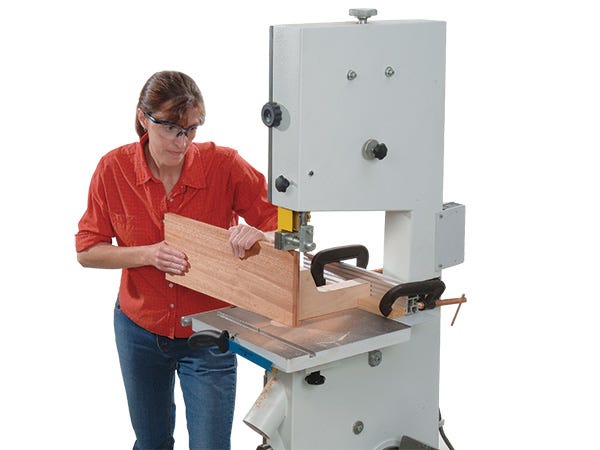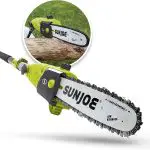To use a band saw, set up the machine, adjust the blade height and tension, choose the appropriate blade for your project, and feed the material through the saw while keeping your hands clear of the blade. The band saw is versatile and can be used for various tasks such as cutting curves, resawing, and making straight cuts.
It is important to prioritize safety while using a band saw and follow proper guidelines to avoid accidents or injuries. Band saws are essential tools in woodworking and metalworking, allowing for accurate and efficient cutting. Whether you’re a beginner or an experienced user, knowing how to use a band saw can greatly enhance your craftsmanship.
In this guide, we will walk you through the step-by-step process of using a band saw, from setting up the machine to performing different cuts. We will also provide safety tips and highlight the various applications of a band saw. With this knowledge, you’ll be able to maximize the potential of your band saw and achieve precise and professional results in your projects.
Making Basic Cuts With A Band Saw
A band saw is a versatile tool that can be used for various types of cuts. For straight cuts, you need to adjust the blade and make sure it is parallel to the fence. Guide the material steadily through the blade while keeping your fingers away from the cutting path.
When it comes to curved cuts, turn off the saw and release the tension on the blade. Insert it into the hole, turn it on, and slowly follow the desired curve. Beveled cuts can be achieved by tilting the table or the material itself.
Rip cuts are made by using the fence to guide the material along the length of the blade. Lastly, resawing involves cutting a board into thinner pieces by guiding it along the blade with a fence or guide. By following these steps, you can effectively use a band saw for various cutting tasks.
Advanced Techniques And Tips For Precision Cutting
Precision cutting with a band saw involves advanced techniques and tips. When cutting rounded corners, position the workpiece at the desired angle. For cutting circles, use a compass to mark the center and guide the blade. Notches and dadoes can be achieved by making multiple cuts and cleaning up with a chisel.
Book matching involves cutting a piece of wood and flipping it to create a mirrored pattern. Cutting walnut panels requires a sharp blade and slow, steady movements. When cutting wide panels, use a fence or sled for added stability. These techniques will help you make accurate and clean cuts with a band saw.
Safety Precautions And Best Practices
When using a band saw, it is crucial to prioritize safety precautions and best practices. One important measure is to use a push stick to guide the material being cut. Additionally, utilizing a band saw fence allows for more precise and controlled cuts.
Proper blade tensioning is essential to ensure clean and accurate cuts, while regular blade maintenance and replacement contribute to optimal performance. Equally important is wearing safety gear and personal protective equipment, such as safety glasses and gloves, to minimize the risk of injury when operating the band saw.
By following these guidelines, users can safely and effectively utilize a band saw for various woodworking tasks.

Credit: www.rockler.com
Troubleshooting And Common Band Saw Issues
Troubleshooting and Common Band Saw Issues: Blade Drift, Uneven Cuts, Blade Dullness, Band Saw Alignment Blade drift is a common issue when using a band saw. It refers to the blade veering off course during the cut, resulting in uneven cuts.
To minimize blade drift, make sure the blade tension is correct and allow the saw to reach full speed before cutting. Uneven cuts can also be caused by a dull blade. Regularly check the blade for sharpness and replace it when necessary.
Band saw alignment is crucial for accurate cuts. Check that the blade is properly aligned with the guides and the tires. Adjust the guide bearings if needed. Maintaining these troubleshooting tips will help you effectively use a band saw and achieve precise and clean cuts.
Choosing The Right Band Saw For Your Needs
Choosing the right band saw for your needs involves considering various key features. Different types of band saws are available, including horizontal, vertical, and hand-held options. Each type has its own advantages and suitable applications. When selecting a band saw, popular brands such as Dewalt, Milwaukee, Craftsman, and others should be considered for their reliability and quality.
Additionally, there are budget-friendly options available for those with limited funds. Beginners may benefit from recommendations provided by woodworking experts to ensure they start with a user-friendly and efficient band saw. By carefully considering these factors, you can find the perfect band saw for your woodworking projects.
Frequently Asked Questions For How To Use A Band Saw?
How Do You Properly Use A Bandsaw?
To properly use a bandsaw, follow these guidelines: 1. Set up the bandsaw correctly. 2. Choose the appropriate blade for your cutting needs. 3. Make sure the material is securely clamped. 4. Use proper technique and feed rate to guide the material through the saw.
Remember to prioritize safety by wearing protective gear and ensuring the saw is properly maintained.
What Are 5 General Guidelines For Using The Band Saw?
To properly use a band saw, follow these 5 general guidelines: 1. Wear appropriate safety gear, such as safety glasses and gloves, before operating the band saw. 2. Adjust the blade tension and guide blocks to ensure proper tracking and smooth cutting.
3. Position the workpiece securely on the saw table and use a push stick or miter gauge when necessary. 4. Keep your hands a safe distance away from the blade and avoid pushing too hard or forcing the cut. 5.
After completing the cut, turn off the band saw and wait for the blade to come to a complete stop before removing the workpiece. Follow these guidelines to use a band saw safely and effectively.
What Are 3 Uses For A Band Saw?
A band saw can be used for cutting rounded corners, cutting circles, and resawing.
What Is The Most Common Use For A Band Saw?
A band saw is most commonly used for cutting rounded corners, circles, resawing, cutting notches, and book matching.
Conclusion
Using a band saw can open up a world of possibilities in your woodworking projects. With the right techniques and safety precautions, you can make precise cuts, create smooth curves, resaw thick boards, and more. By understanding how a band saw works and following proper setup procedures, you’ll be able to maximize the potential of this versatile tool.
One of the top uses for a band saw is cutting rounded corners and circles, allowing you to add beautiful details to your projects. Additionally, by utilizing push blocks instead of a band saw fence, you can safely cut notches and book match your wood for a seamless look.
Resawing and cutting wide panels are also made easier with a band saw, giving you the ability to work with thicker stock and create stunning designs. Remember, always prioritize safety when using a band saw. Choose the right blade for the task at hand, and make sure to adjust the height of the blade guard for optimal protection.
Bandsaw safety should never be overlooked. Now that you have a basic understanding of how to use a band saw, go ahead and try out these techniques for yourself. With practice and patience, you’ll become more confident in your woodworking skills and be able to utilize the full potential of this essential tool.
Happy sawing!


















